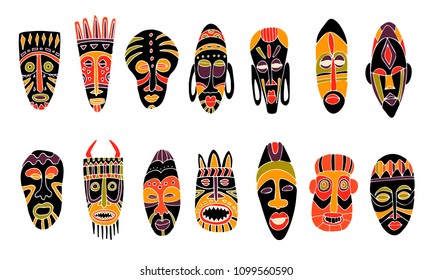African Masks, Renowned and Admired Form of Art
African masks are considered among the most renowned and admired form of art in African continent. These masks reflect inherent forms and ideas thereby making them extremely relevant in African culture (Art.com). The creativity of African masks is self-apparent considering that they portray the mainstream cultures of this unique society. However, these masks have a profound meaning for those who make them. In other words, the form of the mask is a physical mechanism to commence change whereby the person who wears it assumes another entity. This act eventually enables him to influence the spirits to whom he offers his gratitude or attraction. African masks are significant since they express a high level of spirituality. This essay discusses the history, visual features, importance, meaning, and use of African masks as a form of art.
Cultural Importance of Masks
Cultures in most African communities depict the struggle of human beings to harmonize through customary festivals. People wear masks to be connected to their gods. Magic is among the various elements that complete the society in the model of Parrinder. Different African societies wear different masks to exemplify distinct gods and spirits. For instance, a mask in Central Africa would be different from the masks drawn from West Africa. According to the Art.com, the African masks yielded several powers on the people. Besides the exemplification of spiritual forms, these masks had a deeper meaning of the existing African arts and design. It must be mentioned here that only highly artistic and creative individuals would be allowed to design these masks. In the Yoruba culture, the masks in Gelebe are believed to defend people from witches through the employment of supernatural means including magic, dance, and sculptures. The mask of Gelede, displayed in the Lewis E. James Art Museum, has human and animal features signifying the spirits of their ancestors.
Concept and Visual of Masks
The most common exhibits in Yoruba are the masks in Gelede; colorful masks put on by men. They amalgamate ritual dance and art to amuse, enlighten, and motivate the practice of worship. The masks evoke dignity and integrity. They are mainly composed of formal symmetrical arrangements of form, shapes, and lines in figures. The texture involves expert craftsmanship, finished quality, and fine details symbolizing the tribal art in Africa. They also have extremely refined surfaces along with signifying a youthful healthy skin. In the modern-day Nigerian museums, the masks show different generational skills in arts to exemplify the African traditional beliefs in spirits. The healthy skin reflects the concept of virtue and beauty while evil and fear are represented through rough and dirty surfaces. Most African carvings depict the idealized figure of a person in its prime; brimming with strength, virility, health, and celebration of fertility (Segy 27).
African masks assume several forms; elongated, circular, human-like or animal-faced, oval, rectangular, or a combination of several shapes and objects. The abstraction and simplification of visual components in the African mask art stress its extensive power. Ideally, these masks were carefully designed to portray the contemporary arts in African society. Aspects of texture correlated with the mainstream arts of the time. Likewise, there was a generational improvement in the design of these masks demonstrating maturity and growth in the African arts and architecture.
Origins of the African Masks
The origins of the African mask date back long before documented history. African mask in the Sahara in Niger has carvings that are almost 6000 years old. Alongside Sub-Sahara Africa, the cultural arts in the west, antique artifacts, paintings in Egypt, and southern skills also contributed significantly to the progression and development of art in Africa (Rupert 129). Often portraying the surrounding nature, the sculpture was usually abstract translations of plant life, animals, or natural shapes and designs. The Kush kingdom of Nubian in contemporary Sudan was in a close yet hostile contact with Egypt. They generated monumental art mostly derivative in forms. In West Africa, the initially recognized paintings are from the Nok culture which flourished between 500 BC and 500 AD in present Nigeria. These clay figures were normally designed using angular shapes and elongated bodies. Although mundane, these shapes created a benchmark for future prosperity in the African arts and architecture.
Complex Approaches in 10th Century
More complex approaches in generating art were established in Sub-Saharan Africa in the 10th century. Among the most prominent developments were brass castings, the metalwork, the terracottas of IIe Ife Bronze, and the bronze work of Igbo Ukwu. These were typically decorated with valuable stones and ivory and were highly esteemed in most West African countries. The African masks were, at times, being restricted to the work of court artisans and recognized with royalty, just like the Benin Bronzes.
Beliefs Related to the Masks
Masks are typically worn by men. They are utilized to invite the spirits of their ancestors to take part in festivals such as weddings, births, funerals, naming, and initiations. The spiritual link conveyed by putting on masks during the events is crucial because it satisfies the order in society. Masks have specific importance in the cultural customs of Africa’s Yoruba tribe (Ola 17). These masks are also used for burial and religious ceremonies. In addition, they are used during a dance known as Dama. The individuals believe that Dama dance forms a bridge into the peace. The religious customs witnessed by the African people assist to link them with the gods.
Artists in Africa use their creativity and skill to integrate different meanings and concepts into the work of art. According to the African Art Documentary, the African art is a depiction of the traditional values and spirits. This documentary symbolizes the thriving African masks trade and its significance to this society. It also shows how best masks are transported to Europe wherein people can witness the fine side of the African culture and arts.
Different Meanings and Concepts
As mentioned earlier, African artists use their creativity and expertise to integrate different meanings and concepts into their work of art. This is observed in making of masks; a father passes it on to his son together with the understanding of the symbolic meanings conveyed through the masks. The continuity of making masks in African culture shows that Africans are individuals who revere their culture and make all endeavors to uphold it for future generations.
Hence, museum art counteracts the view that Africans are uncultured and primitive. The attractive art displayed is an example of the craftsmanship and proficiency needed to form a great piece of art.
The texture and facial expressions show the meaning of different art pieces. Head monuments are stretched out representing head as the core of thoughts, feelings, and character. On the same note, the generational designs of these masks spurred earlier civilization in the African culture. For instance, artists were specially ordained with the mandate of designing the masks. They were generally respected in society thereby experiencing the first tag as the community professionals. In some contexts, the artists organized special training ultimately generating a massive influx of people to the centers wherein such practices were thriving.
In a nutshell, the African mask is one element of arts that triggered generational changes in society. Similarly, other areas of African architecture grew from the influence of mask-making.
The Museum Demonstration
The museum demonstrates that the people of Kuba own a mask – Ngady a Mwaash. People wear this mask to respect the King of Kuba and to promote the women’s role of culture in the society. In most cases, the mask is worn by a participant or a dancer in rituals (Rule 140). Some forms of masks are put on by both genders. Generally, masks are inclined to signify beings or spirits significant to the ceremony where the mask is utilized. The person who wears the mask is typically believed to be capable of communicating with the being represented by it. Also, the wearer is believed to be possessed by what or who is represented by the mask.
Religious and Social Importance
In African cultures, masks are not ornaments or playthings. They serve a significant role in ceremonie and different events to guarantee a good harvest. They also address the demands of a tribe in moments of combat or peace, or convey presence of spirits in burial rituals or initiation ceremonies. Other masks signify totem animals – significant creatures to a specific group or family. In specific cultures such as Zaire’s Kuba culture, masks symbolize particular figures in the mythology of tribe such as a king or a competitor to the monarch. Since each mask has a particular spiritual meaning, majority of traditions make up various traditional masks. For example, the religion of tradition of the Dogon individuals in Mali makes up three major cults.
African masks are created by tribes and cultures discovered all over the massive continent of Africa. Both women and men have used them for thousands of years for religious, social, and cultural purposes. I was inspired by the fact that these masks connected people to their gods. By wearing these masks, people connected to the spiritual world to address their issues to these gods. This was also a form of connectedness to these spirits. Furthermore, it was interesting to note that the wearer was believed to be possessed by what or who is represented by the mask. This is supported by the fact that the wearer of the mask may be given the mask of a specific prominent figure in the society.
References
Art.Com. African masks, the Contemporary African Arts.
https://www.contemporary-african-art.com/african-masks.html
Ola Orie, O. (2011). The structure and function of Yoruba facial scarification. Anthropological
Linguistics, 53(1), 15-33.
Rule, Audrey et al. African Mask-Making Workshop: Professional Development Experiences of
Diverse Participants. International Journal of Multicultural Education 17(2): 135-157,
Rupert, Janet E. The African Mask. Lincoln, NE: iUniverse, 2005. Print.
Segy, Ladislas. Masks of Black Africa. New York: Dover Publications, 1976. Print.
The Film, the African Art – The Market of Masks (Documentary of 2015).

